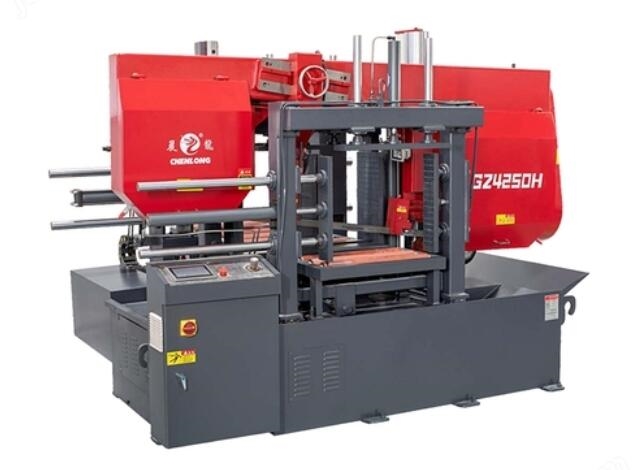Unlocking Precision: The Engineering Marvel of CNC Profile Sawing Machines
Introduction
In the hyper-competitive world of industrial manufacturing, achieving millimeter-perfect cuts on metal profiles isn’t just a goal—it’s a non-negotiable standard. Enter the CNC profile sawing machine, a technological titan transforming aluminum extrusions, steel bars, and composite materials with surgical accuracy. Beyond its robust exterior lies a symphony of motors, sensors, and software that redefines efficiency. Let’s dismantle this engineering masterpiece layer by layer.
The Digital Brain: CNC System Mastery
At the core of every modern sawing machine resides its CNC system—an orchestrator transforming human commands into mechanical ballet. Imagine inputting parameters like cut length (±0.1mm tolerance), miter angles (up to 60°), and batch quantities through an intuitive HMI touchscreen. The system’s processor converts these inputs into thousands of motion vectors per second, dynamically adjusting for material flex and thermal expansion in real-time.
Modern CNC units now incorporate adaptive control algorithms, learning from past cuts to predict blade wear or material inconsistencies. This isn’t just automation; it’s machine intelligence ensuring repeatability across 10 or 10,000 parts.
Feeding Mechanism: The Art of Micron-Level Precision
Gone are the days of manual feed adjustments. Today’s servo-driven feed systems use high-resolution encoders to position profiles with accuracy down to 5 micrometers. Here’s how it works:
- Ball Screws & Linear Guides: Servo motors drive hardened ball screws to move the material-holding fixture along frictionless linear rails, eliminating backlash.
- Smart Clamping: Pneumatic or hydraulic clamping arms adapt pressure based on profile geometry—preventing distortion on thin-walled tubes without crushing solid billets.
- Multi-Axis Coordination: Simultaneous 4-axis movement allows oblique cuts while maintaining feed speed consistency.
This system isn’t just precise; it’s predictive. It anticipates inertia during deceleration, ensuring the saw never overshoots its mark.
Sawing Mechanism Engineering: Where Force Meets Finesse
The cutting phase is a ballet of kinetic energy and structural integrity:
High-speed cutting with seamless chip evacuation
- Twin-Saw Configurations: Dual opposing blades reduce vibration by counteracting lateral forces, enabling faster cuts through heavy sections.
- Hydrodynamic Damping: Cutting forces are absorbed by hydraulic cushions in the saw carriage, preventing harmonic chatter even at 3,000 RPM.
- Tool Intelligence: RFID-equipped blades communicate wear rates to the CNC, triggering automatic offset adjustments or tool-change alerts.
Advanced machines now feature high-frequency spindle drives capable of controlling torque during hard-material penetration, extending blade life by 40% compared to conventional systems.
Cooling & Chip Management: The Unsung Heroes
Cutting generates intense heat—a menace to both dimensional accuracy and tool longevity. Modern solutions tackle this with sophistication:
- Vortex Tube Coolant Systems: Air-driven tubes generate sub-zero coolant streams without refrigeration units, targeting heat zones with pinpoint accuracy.
- Three-Stage Filtration: Magnetic separators remove ferrous chips, rotary drums capture fines, and centrifugal cleaners recycle coolant—achieving 99% purity.
- Negative-Pressure Evacuation: Self-cleaning conveyor belts move chips away under vacuum, eliminating manual clearing downtime.
These innovations transform waste into value—recycled chips become raw material, while closed-loop coolant systems save 500+ liters annually.
Beyond Cutting: Industry 4.0 Integration
The newest generation of sawing machines are data powerhouses:
- OEE Dashboards: Real-time metrics (setup time, cut cycles, blade life) identify bottlenecks via integrated IIoT sensors.
- Digital Twins: Simulate complex cutting sequences offline before executing them flawlessly on the shop floor.
- Blockchain Logging: Each cut gets cryptographically stamped for quality traceability from raw material to end product.
Automotive leaders leverage these features to achieve lights-out manufacturing, with overnight operations cutting 10 tons of aluminum without human supervision.
Conclusion: The Future Carved in Metal
CNC profile sawing machines represent the zenith of precision engineering—where mechanics, software, and material science converge. As AI-driven predictive maintenance and carbon-fiber blades enter mainstream use, these workhorses will push the boundaries of what’s possible in aerospace framing, architectural glazing, and electric vehicle battery tray production.
For manufacturers worldwide, investing in this technology isn’t just about faster cuts; it’s about claiming a competitive edge in the relentless pursuit of perfection. Every slice of metal isn’t merely a cut—it’s a statement of technological ambition achieved.

















